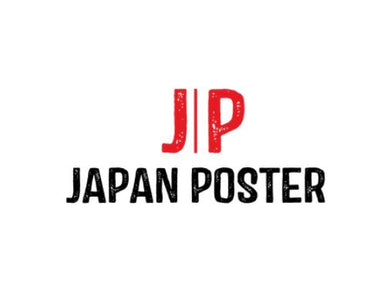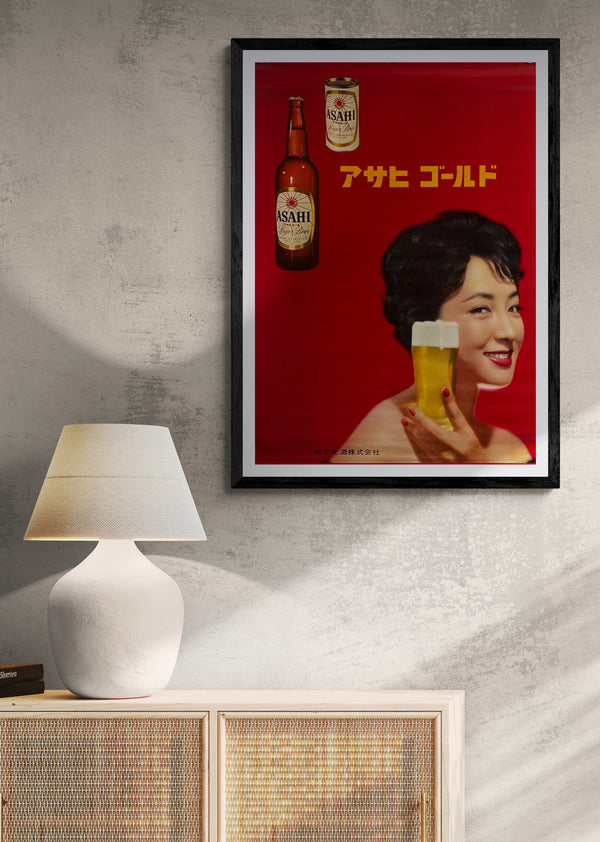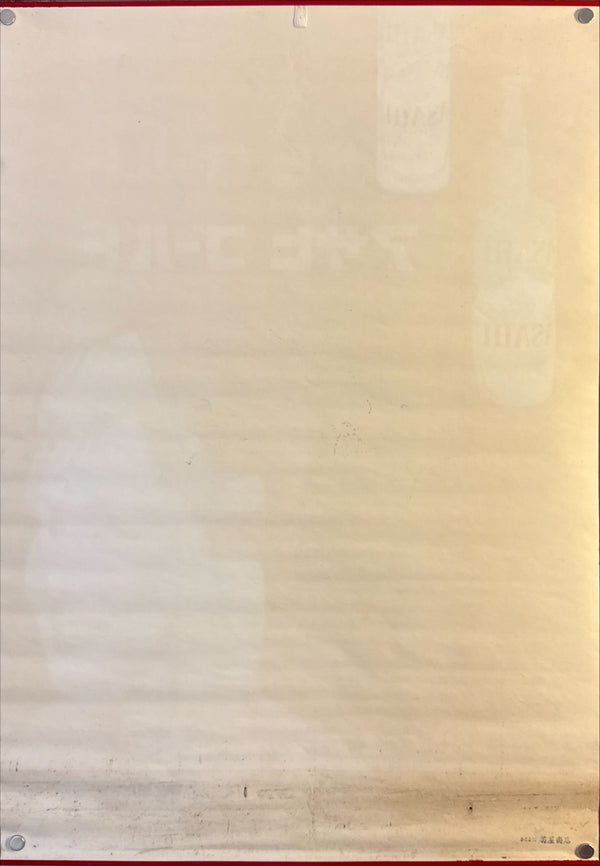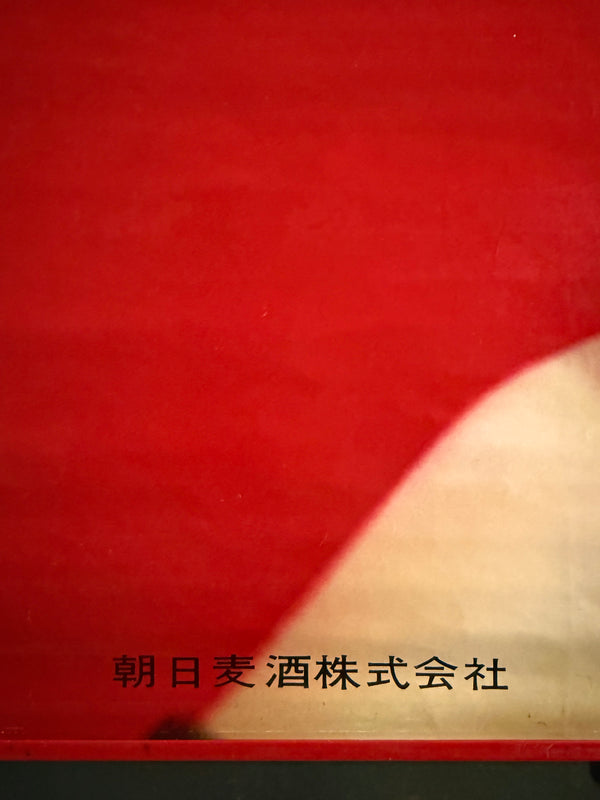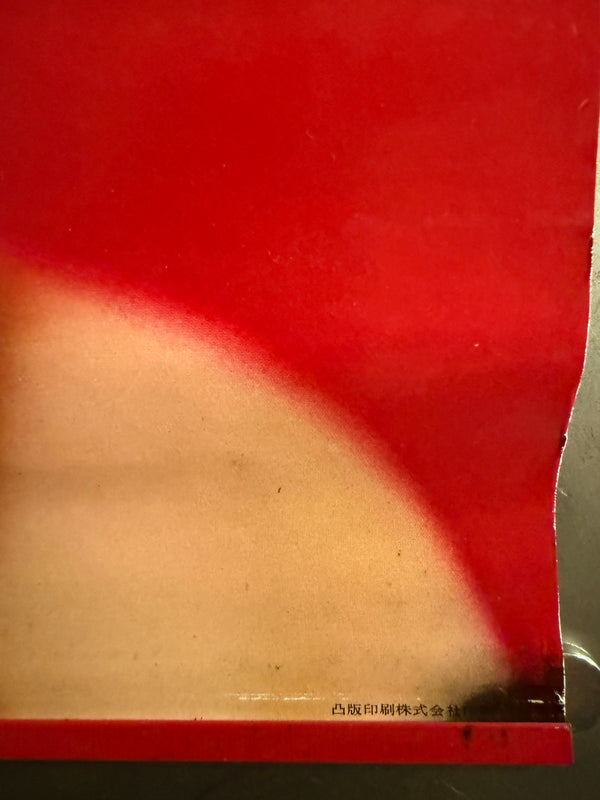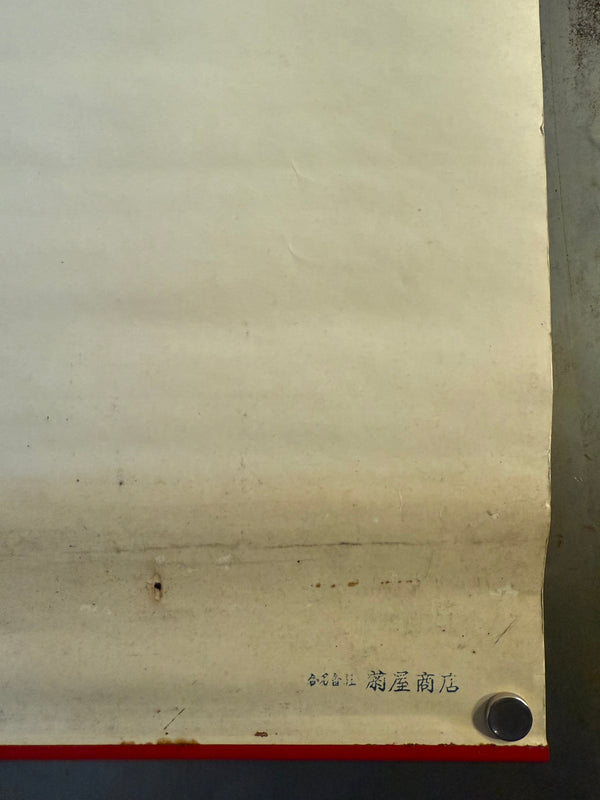
"Asahi “Gold” (アサヒ ゴールド)", Original Ultra Rare Japanese Advertising Poster c.1958–1962, B2 Size (c.51 × 73 cm) O473
Asahi “Gold” (アサヒ ゴールド)
Original Japanese Advertising Poster — B2 (51 × 73 cm) — Ultra‑Rare / c.1958–1962
Maker / Brand: Asahi Breweries, Ltd.(朝日麦酒株式会社)
Printer: Toppan Printing Co., Ltd.(凸版印刷株式会社) — credit printed at lower right border
Format / Technique: Lithograph in rich spot colours on thin commercial stock
Authentication: Guaranteed original mid‑century Japanese point‑of‑sale poster. Certificate of Authenticity included.
Why this is a trophy piece
-
Japan’s first canned beer. “Asahi Gold” (アサヒ ゴールド) launched in 1958 as the first canned beer in Japan, a watershed in everyday life and retail culture. This poster trumpets that modernity with a glamour image and the new can front‑and‑centre.
-
Early Showa advertising, gorgeously printed. The design distills late‑1950s optimism into a single sheet: a deep crimson field, a smiling model raising a tall glass with dense white head, and the product pair—bottle + can—floating like badges of modern taste.
-
World‑class design pedigree. The label/can graphics were created by Raymond Loewy in 1957—foil‑accented “rising sun” motif, bold ASAHI logotype and elegant “Lager Beer” script. The museum‑catalogued Loewy Asahi Lager label (1957) and Asahi’s own release notes confirm the association.
-
Ultra‑rare format and survival. Mid‑century Japanese beverage posters were shop‑front workhorses; few were saved. This is the first time we have handled this exact Asahi Gold B2 style.
Design notes (what you’re seeing)
-
Headline (center, in yellow): アサヒ ゴールド — Asahi Gold.
-
Product depictions: At top‑left, the steel “flat‑top” can (no pull tab), and the long‑neck bottle, both wearing Loewy’s label: a red rising sun with radiating rays behind strong ASAHI roman letters and cursive “Lager Beer”; the use of metallic/foil printing in this era gave a premium sparkle at point‑of‑sale. (Loewy’s label is documented as foil + paper; Toppan is credited as printer.)
-
Bottom publisher’s line (black type): 朝日麦酒株式会社 — Asahi Breweries, Ltd.
-
Right‑edge printer’s credit: 凸版印刷株式会社 — Toppan Printing Co., Ltd.
-
Verso shop stamp (blue): 合名会社 菊屋商店 — Kikuya Shōten (General Partnership) — a period liquor merchant’s mark, reinforcing genuine retail use.
Dating the piece (c.1958–1962)
-
The poster promotes Asahi Gold and shows the pre‑pull‑tab steel can that was opened with a church‑key—standard from the 1958 launch until packaging improvements mid‑’60s (aluminium top in 1964, pull‑tab the following year; all‑aluminium in 1971). That places this artwork squarely in the late 1950s to very early 1960s.
-
The corporate name 朝日麦酒株式会社 (Asahi Breweries) is consistent with the period; the company would not reorganize its naming in English until later decades.
Cultural context
When Asahi Gold arrived in 1958 (350 ml, ¥75), it reframed beer as a mobile, modern convenience—easier to chill, to store in home refrigerators, and to take on leisure trips. Japanese media credited it with accelerating the shift from bottle to can in everyday drinking. The poster’s “model + product” composition—clean background, saturated colour, air‑brushed glamour—captures the optimism of early high‑growth Japan and the international polish Asahi sought via Loewy’s design language.
Condition
Excellent for its age and commercial purpose; unrestored, not linen‑backed.
-
Strong, even colour across the deep red field; clean image of the model and product.
-
Minor handling/edge touches, a few tiny age freckles and light toning on the verso; tiny corner nick at a margin (see close‑ups).
-
Presents with superb wall power; frames beautifully in B2.
Please refer carefully to the provided images—you are viewing the exact poster for sale.
Summary
-
Original Japanese B2 (51 × 73 cm) advert for Asahi Gold, c.1958–1962.
-
Design lineage: Raymond Loewy × Toppan Printing
-
Historic first: celebrates Japan’s first canned beer (1958), shown in its steel, church‑key era form.
-
Ultra‑rare survivor of mid‑century Japanese beverage advertising.
-
Not a reproduction or reprint.
-
Certificate of Authenticity included.
